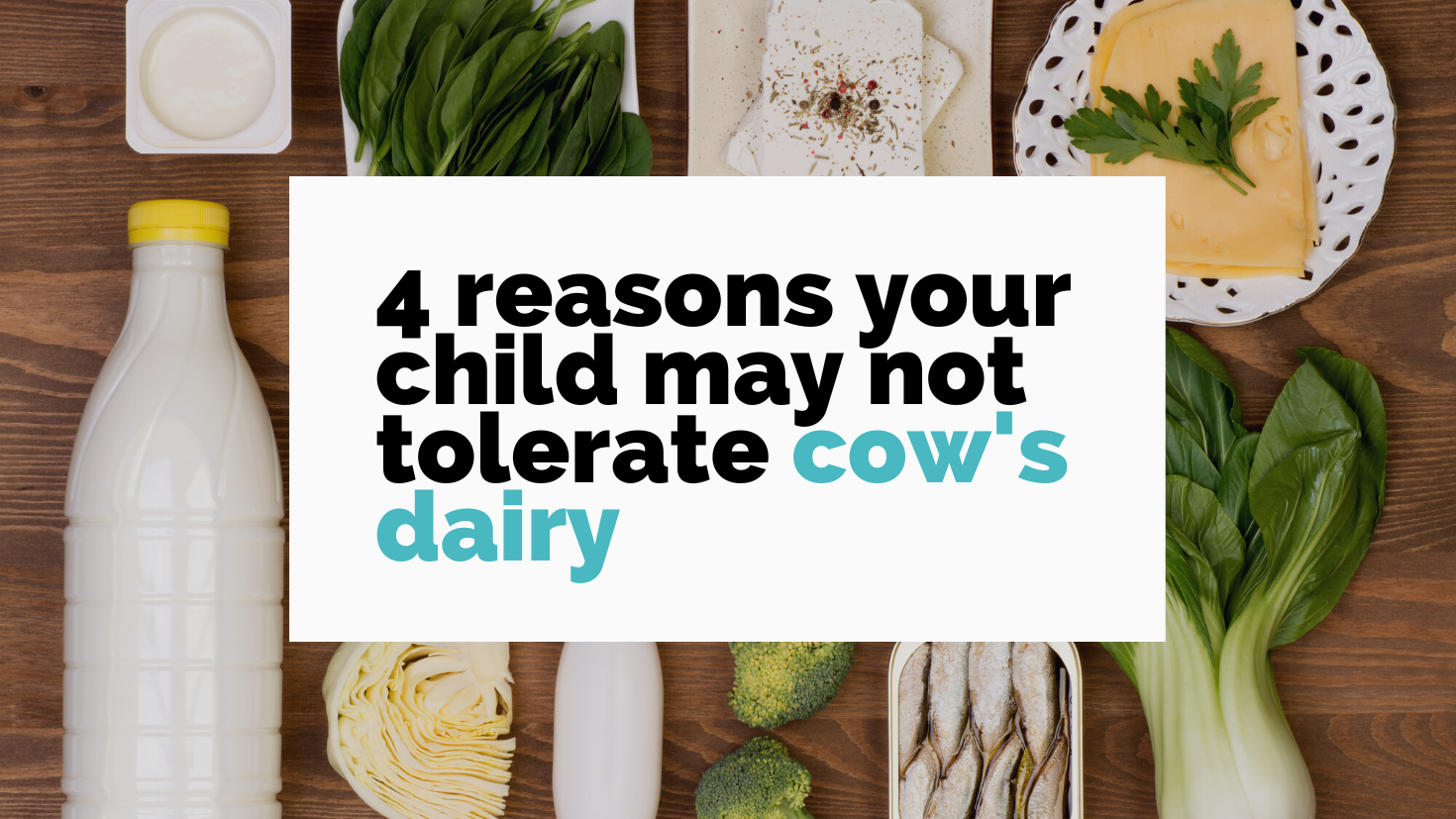
4 ways your child may not tolerate cow’s dairy: allergy, milk protein sensitivity, cerebral folate deficiency, and lactose intolerance
- 4 ways your child may not tolerate cow’s dairy: allergy, milk protein sensitivity, cerebral folate deficiency, and lactose intolerance - January 3, 2024
- 5-hydroxytryptophan (5-HTP) and the “feel good” neurotransmitter serotonin - October 4, 2023
- Quercetin supplementation for children: research, safety and efficacy - May 13, 2023
People may choose to avoid milk products for a variety of reasons, but often they don’t understand the differences in a true milk allergy, a milk protein intolerance, and lactose intolerance. In this article, we’ll discuss the unique causes, symptoms, and treatments related to each condition. Please note that not all children are milk-intolerant or allergic! If your child has no negative reactions to milk then there is no medical reason to entirely eliminate it from their diet.
Milk Protein Allergy (IgE-mediated response)
A milk allergy differs from a milk intolerance in how the immune system responds. A milk allergy involves an immunological response to the proteins in milk, typically casein or whey. A milk intolerance is a non-immunological response that’s often the result of digestive issues.
A milk allergy is diagnosed using a skin prick or blood test that looks for immunoglobulin E (IgE) antibodies. IgE antibodies are released by the immune system when the body is exposed to substances it’s sensitive to and in turn, they release the chemicals that cause allergic symptoms.1 Symptoms of an allergic response occur immediately and include swelling of the airways, shortness of breath, vomiting, hives, a drop in blood pressure, dizziness, and fainting.1 During a skin-prick test, liquid milk protein is applied to the skin. Then, an allergist pricks the skin with a small probe to allow the protein to enter the skin. If a welt appears within 15-20 minutes, it most likely indicates an allergy. Alternatively, a blood test can test for the presence of IgE antibodies.1 Individuals with true milk allergies are encouraged to carry an Epipen to use in instances of anaphylactic shock.1
Approximately 2-3% of children under the age of 3 years old have a true milk protein allergy.1 Fortunately, about 80% of them will outgrow the allergy by the age of 161. Milk allergies are treated with strict avoidance of milk proteins found in all dairy foods and in other, sometimes surprising, non dairy products. Whey and casein can be found in meat products, sausage, chips, dips, cereals, and even gum. It’s important to read the Nutrition Facts Label on all packaged foods if your child has a true milk protein allergy.
Alternatives to avoiding milk proteins are allergy shots or sublingual immunotherapy (SLIT). These forms of treatment provide systematic desensitization to milk by regularly exposing the body to small amounts of milk protein. SLIT requires taking a daily milk protein pill under the tongue to achieve “allergen specific desensitization”.2 SLIT has been found most effective in peanut allergies, but can help marginally improve the symptoms associated with a milk allergy.2 Unfortunately, SLIT is not curative, meaning it requires ongoing daily therapy and does not achieve long-term tolerance.2 However, SLIT can provide a sort of safety net for children with extreme allergies in case they accidentally consume milk proteins.
Milk Protein Intolerance
Milk protein intolerance differs from a milk protein allergy because it does not trigger an IgE-mediated immunologic response. Instead, the body has an inflammatory reaction to the proteins in milk, casein and whey. This more generalized inflammatory response often results in delayed reactions, occurring hours to days after ingestion. The symptoms usually affect the skin and gastrointestinal tract and include atopic dermatitis (eczema), diarrhea or constipation, bloody stool (especially in babies), reflux, poor growth or food refusal, iron deficiency anemia, and colic.3 In some cases, immediate symptoms like a dry cough, vomiting, or wheezing can occur with an intolerance, but more severe immediate symptoms like respiratory distress indicate an allergy and require immediate medical attention.
At times milk protein intolerance can triggered by an IgG-mediated immunologic response. This is an entirely different antibody class than IgE and again does not cause hives or anaphylaxis. The role of testing IgG antibodies for food intolerances or sensitivities is controversial. The American Academy of Allergy, Asthma and Immunology states that “The presence of IgG is likely a normal response of the immune system to exposure to food. In fact, higher levels of IgG4 to foods may simply be associated with tolerance to those foods.”
However, it is my medical opinion that testing IgG responses to foods can be useful in a few select situations. A few small studies show that dietary restriction based on IgG food sensitivity testing reduces number of migraine headaches. One study also suggests that a diet that excludes foods based on IgG testing also increases quality of life and reduces Irritable Bowel Syndrome symptoms. In my opinion, IgG food sensitivity testing is best used to guide a temporary elimination diet for patients. I typically recommend no more than 30 days of an elimination diet before reintroducing foods.
Cow’s Milk, Folate & Autism Spectrum Disorder
Children with cerebral folate deficiency (CFD) may be sensitive to cow’s milk for an entirely different reason! CFD is a disorder characterized by low levels of 5-MTHF, the active form of folate, in the central nervous system (CNS) but normal levels of folate metabolites in the bloodstream.4 That means there’s enough folate in the body but it isn’t being transported into the brain, leading to central nervous system deficits and symptoms like difficulty walking, balancing, and speech abnormalities.4 CFD is common in children with neural tube defects and affects approximately 70% of children with Autism Spectrum Disorder (ASD)5.
The most common cause of low folate in the CNS is the presence of folate receptor (FR) antibodies that block folate transport into the brain.5 Cow’s milk contains a form of FR antibodies that look very similar to those of humans. In fact, they’re so similar that they can trigger an immune response, producing antibodies that react with the human FR antibodies and block folate transport into the central nervous system.
Since cow’s milk contains substantial amounts of FR and can act as the trigger for the antibody response, avoiding milk has been researched to determine its impact on these antibodies in children with ASD. Studies show that three months of a milk-free diet can significantly reduce the number of folate receptor antibodies while re-exposure to milk proteins is followed by an increase in the antibodies.4 These studies suggest that a milk-free diet may down-regulate the FR antibodies, allowing folate transport into the brain, ultimately improving neurological deficits in children with ASD.5
Although a dairy free diet cannot cure anything, it can be beneficial for children with ASD who may not be getting enough folate to their central nervous systems. Dietary interventions like removing milk and milk products are low risk and relatively simple. Replacing milk with plant milks and carefully reading the Nutrition Facts Labels can help navigate you in the right direction. Additionally, supplementing with folinic acid, a type of folate that can enter the CNS without folate receptors has been found to significantly improve speech, language and social interaction in children with ASD.5
Lactose Intolerance
Lactose is the primary carb found in milk and milk products. Lactose intolerance is a condition characterized by a loss of lactase enzymes, resulting in lactose malabsorption and symptoms such as abdominal pain, bloating, gas, nausea, and diarrhea.
Lactase is an enzyme produced in the brush border, the cells that line the walls of the small intestine. These cells can be damaged by conditions such as celiac disease, SIBO, and dysbiosis, and when they’re damaged, absorption is severely limited, leading to symptoms of lactose intolerance. In some instances, improving the health of one’s gut may increase their tolerance to foods containing lactose. For example, eliminating gluten in celiac disease and addressing dysbiosis in SIBO may heal the brush border and restore adequate lactase production.
Lactose intolerance affects approximately 70% of the world’s population. People of African and Asian descent are genetically predisposed to lactose intolerance, while those from northern European regions often retain their ability to digest lactose.6 Many children lose their ability to digest lactose around the age of 4-5 years old. It’s important to note that breast milk does contain lactose and babies who are cow’s milk sensitive are typically not lactose intolerant. Rather, they may have a sensitivity to the proteins (casein or whey) found in cow’s milk.
Different dairy products contain different amounts of lactose and oftentimes people have a unique threshold for how much lactose their body can tolerate. Hard cheeses like swiss and parmesan, cottage cheese, feta, and greek yogurt tend to have lower concentrations of lactose. If you or your child struggle digesting dairy products, play around with different amounts of lower lactose foods and/or try a lactase supplement to ease your symptoms.
Summary
I often hear the phrases milk protein allergy, milk protein intolerance, and lactose intolerance used interchangeably. Hopefully this article clarified the differences in these conditions and equipped you to manage them if you or someone in your family is impacted. True milk protein allergies cause an immune response, mediated by IgE antibodies and can be very serious. Milk protein intolerances trigger an inflammatory response, not an immune response, and are generally accompanied by delayed gastrointestinal or dermatological symptoms. Lactose intolerance is very common and the result of too little lactase. In some instances, addressing the underlying cause of low lactase such as celiac disease or SIBO can increase an individual’s tolerance to lactose. As always, tuning into your body’s cues around different foods can help you determine which foods work best for you!
References:
- American College of Allergy, Asthma, & Immunology. Milk and Dairy. ACAAI. 2019.
- Schworer SA, Kim EH. Sublingual immunotherapy for food allergy and its future directions.
Immunotherapy. 2020;12(12):921-931. doi:10.2217/imt-2020-0123 - Caffarelli C, Baldi F, Bendandi B, et al. Cow’s milk protein allergy in children: a practical guide.
Ital J Pediatr. 2010;36:5. Published 2010 Jan 15. doi:10.1186/1824-7288-36-5 - Ramaekers VT, Sequeira JM, Blau N, Quadros EV. A milk-free diet downregulates folate receptor
autoimmunity in cerebral folate deficiency syndrome. Dev Med Child Neurol.
2008;50(5):346-352. doi:10.1111/j.1469-8749.2008.02053.x - Bobrowski-Khoury N, Ramaekers VT, Sequeira JM, Quadros EV. Folate Receptor Alpha
Autoantibodies in Autism Spectrum Disorders: Diagnosis, Treatment and Prevention. Journal of
Personalized Medicine. 2021; 11(8):710. https://doi.org/10.3390/jpm11080710 - National Institute of Diabetes and Digestive and Kidney Diseases. Definition and Facts for
Lactose Intolerance. NIH. 2018.







